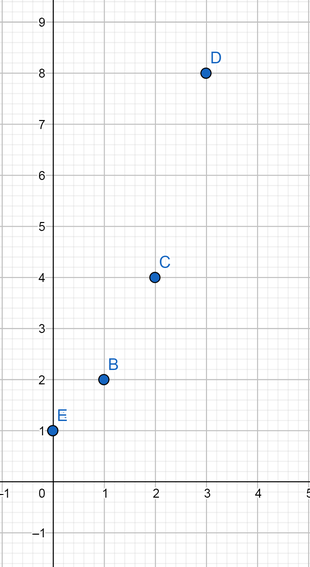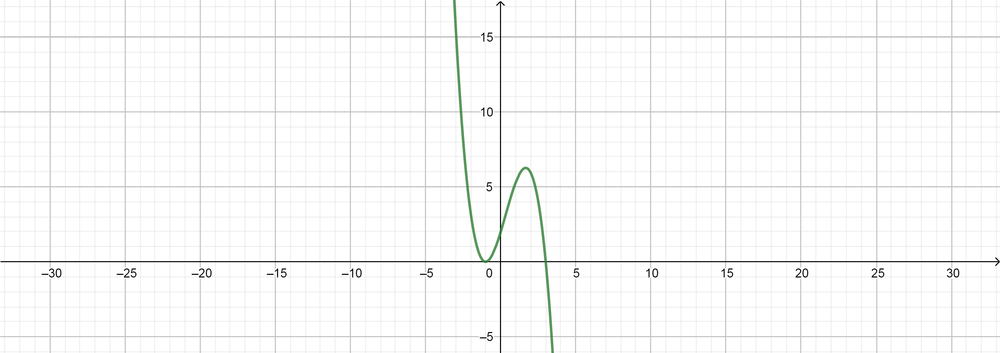
All Solutions
Section 3-1: Exploring Polynomial Functions
$$
text{color{#4257b2}(a) Polynomial function}
$$
Because the degree of exponent function is normal number and degree is $n=4$
$$
text{color{#4257b2}(b) Another function}
$$
Because the degree of exponent function is not normal number and degree is negative number.
$$
text{color{#4257b2}(c) Another function}
$$
Because the degree of exponent function is not normal number and degree is fractional number.
$$
text{color{#4257b2}(d) Polynomial function}
$$
Because the degree of exponent function is normal number and degree is $n=3$
$$
text{color{#4257b2}(e) Polynomial function}
$$
Because the degree of exponent function is normal number and degree is $n=2$
$$
text{color{#4257b2}(f) Another function}
$$
Because the degree of exponent function is not normal number.
$text{color{#4257b2}(c) Another function.}$ $text{color{#4257b2}(d) Polynomial function.}$
$text{color{#4257b2}(e) Polynomial function.}$ $text{color{#4257b2}(f) Another function.}$
$$
color{#4257b2}text{(a)} f(x)=2x^3+x^2-5
$$
The function has a normal exponent number, so the function is a polynomial function.
$$
color{#4257b2}text{(b)} f(x)=x^2+3x-2
$$
The function has a normal exponent number, so the function is a polynomial function.
$$
color{#4257b2}text{(c)} y=2x-7
$$
The function has a normal exponent number, so the function is a polynomial function.
$$
color{#4257b2}text{(d)} y=sqrt{x+1}
$$
The function has an unnormal exponent number$color{#4257b2}left(dfrac{1}{2}right)$, so the function is another function.
$$
color{#4257b2}text{(e)} y=dfrac{x^2-4x+1}{x+2}
$$
The function has divided by another function $color{#4257b2}x+2$, so the function is another function.
$$
color{#4257b2}text{(f)} f(x)=x(x-1)^2
$$
The function has a normal exponent number, so the function is a polynomial function.
text{color{Brown}(a) Polynomial function (b) Polynomial function
\ \
(c) Polynomial function (d) Another function
\ \
(e) Another function (f) Polynomial function}
$$
$$
color{#4257b2}text{(a)} x=0, 500, 1000, 1500, 2000 y=200, 225, 250, 275, 300
$$
First differences as following:
$$
begin{align*}
225-200&=25 250-225=25
\ \
275-250&=25 300-275=25
end{align*}
$$
The first differences are constant, so the linear function is the best modeling for these data.
color{#4257b2}text{(b)} x=0, 1, 2, 3, 4 y=10, 25, 30, 25, 10
$$
First differences as following:
$$
begin{align*}
25-10&=15 30-25=5
\ \
25-30&=-5 10-25=-15
end{align*}
$$
The first differences are not constant, so check the second difference as follows:
$$
begin{align*}
5-15&=-10 -5-5=-10
\ \
-15-(-5)&=-10
end{align*}
$$
The second differences are constant, so the quadratic function is the best modeling for these data.
color{#4257b2}text{(c)} x=1, 2, 3, 4, 5 y=200, 225, 250, 275, 300
$$
First differences as following:
$$
begin{align*}
225-200&=25 250-225=25
\ \
275-250&=25 300-275=25
end{align*}
$$
The first differences are constant, so the linear function is the best modeling for these data.
color{#4257b2}text{(d)} x=0, 1, 2, 3, 4, 5, 6 y=200, 204, 232, 308, 456, 700, 1064
$$
First differences as following:
$$
begin{align*}
204-200&=4 232-204=28
\ \
308-232&=76 456-308=148
\ \
700-456&=244 1064-700=364
end{align*}
$$
The first differences are not constant, so check the second difference as follows:
$$
begin{align*}
28-4&=24 76-28=48
\ \
148-76&=72 244-148=96
\ \
364-244&=120
end{align*}
$$
The second differences are not constant, so check the ratio of $y$ values as follows:
$$
dfrac{48}{24}=2 dfrac{72}{48}=1.5
$$
$$
dfrac{96}{72}=1.3 dfrac{120}{96}=1.25
$$
The ratios of $y$ values are not equal, so the data is represent another function.
text{color{Brown}(a) The linear function is the best modeling for these data.
\ \
(b) The quadratic function is the best modeling for these data.
\ \
(c) The linear function is the best modeling for these data.
\ \
(d) The data is represents another function.}
$$
$$
x=0 y=2^x y=2^0 y=1 (0, 1)
$$
$$
x=1 y=2^x y=2^1 y=2 (1, 2)
$$
$$
x=2 y=2^x y=2^2 y=4 (2, 4)
$$
$$
x=3 y=2^x y=2^3 y=8 (3, 8)
$$
Graph the function for the above point.
(a) Why the person see the graph might think that represent the polynomial function?
Because it seem the quadratic function like a quadratic function.
(b) Explain why this function is not a polynomial function?
Because the degree of exponent number is not a normal number, so this is another function.

text{color{Brown}(a) Because it seems the quadratic function like a quadratic function.
\ \
(b) Because the degree of exponent number is not a normal number, so this is another function.}
$$
text{color{#4257b2}Draw a graph of a polynomial function that has all the following characteristics.
\ \
** $f(-3)=16 f(3)=0 f(-1)=0$
\ \
** $(y)$ intercept is equal $(2)$ ** $f(x)ge0$ when $x3$ ** The domain is set for all real number}
$$
The graph has a zero point is, $(x=3)$ so this graph is represented to the cubic function with two turning points as follows:
$$
f(x)=-0.66 (x-3)(x+1)^2
$$
There are many graphs have the same characteristics.

text{color{Brown}$$f(x)=-0.66 (x-3)(x+1)^2$$}
$$
$$
begin{align*}
y&=3x^2+5x+2,\
y&=2x^2+dfrac{4}{3}x+2,\
y&=23x^2-15x+2…
end{align*}$$
Note that all of these function have different zeros and different values for the same value of $x$, but all of them has the $y$ intercept equal to $2$.
Also, note that the first function has zero for $f(-1)=0$, the second has the value $f(-3)=16$, but none of the other functions have the same characteristics.
calculator from the last time it was used.
To graph the function $y=3x^2+5x+2$ enter the function and press GRAPH. You will see that this function has the intercept with $y$-axis at $y=2$ and its zero, the place that it intercepts the $x$ axis is at $x=-1$, as depicted in *Figure 1*.

*Figure 1.* The graph of the first function

*Figure 2.* The graph of the second function
$$
text{Linear function} f(x)=x+5
$$
$$
text{Quadratic function} f(x)=(x+1)(x+5)
$$
$$
text{Cubic function} f(x)=(x-2)(x+3)(x+4)
$$
$$
text{Quartic function} f(x)=(x+4)(x-8)(x+5)(x+4)
$$
text{color{Brown}(a) $f(x)=x+5$
\ \
(b) $f(x)=(x+1)(x+5)$
\ \
(c) $f(x)=(x-2)(x+3)(x+4)$
\ \
(d) $f(x)=(x+4)(x-8)(x+5)(x+4)$}
$$
$$
text{color{#4257b2}Definition}
$$
The polynomial function is any function that containing the polynomial expression in one variable.
$$
text{color{#4257b2}Examples}
$$
$$
f(x)=6x^3-3x^2+4x-9
$$
$$
text{color{#4257b2}Characteristics}
$$
** The degree of the function is the heights exponent in expression.
** The domain of the polynomials is set for all real number, $[xin R]$
** The range of the polynomials is may be set for all real number or it may be have a lower bound or an upper bound but not both.
** The graph of the polynomials function do not have a vertical or horizontal asymptotes.
$$
text{color{#4257b2}Non examples}
$$
$$
f(x)=sqrt{x+5}
$$

